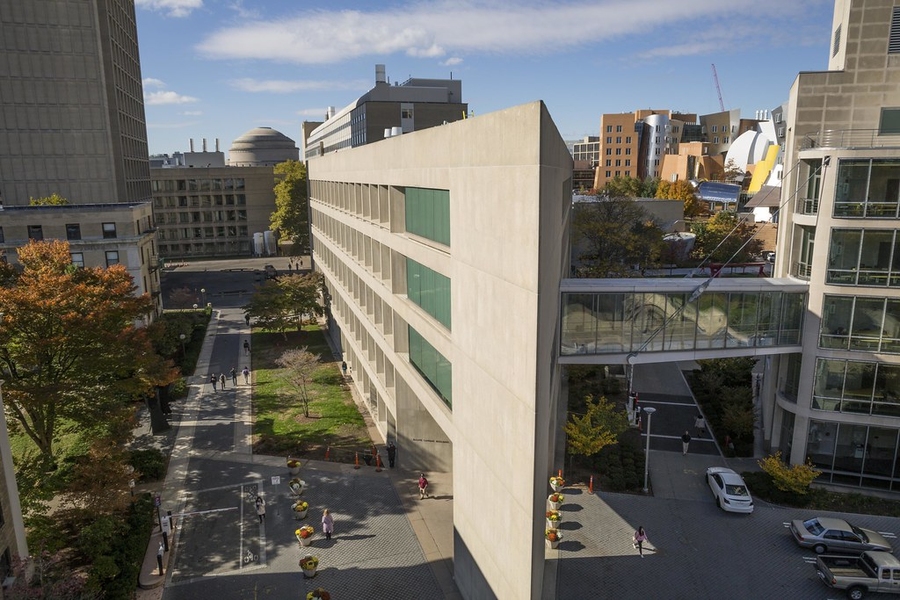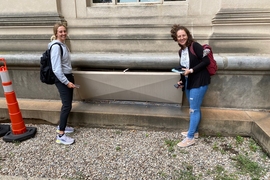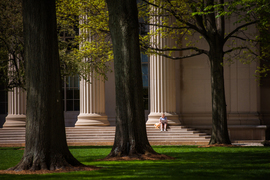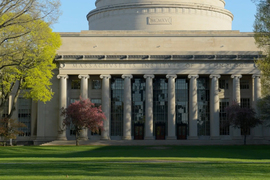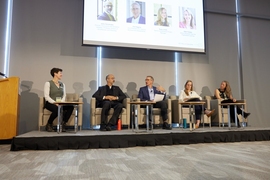Smart thermostats have changed the way many people heat and cool their homes by using machine learning to respond to occupancy patterns and preferences, resulting in a lower energy draw. This technology — which can collect and synthesize data — generally focuses on single-dwelling use, but what if this type of artificial intelligence could dynamically manage the heating and cooling of an entire campus? That’s the idea behind a cross-departmental effort working to reduce campus energy use through AI building controls that respond in real-time to internal and external factors.
Understanding the challenge
Heating and cooling can be an energy challenge for campuses like MIT, where existing building management systems (BMS) can’t respond quickly to internal factors like occupancy fluctuations or external factors such as forecast weather or the carbon intensity of the grid. This results in using more energy than needed to heat and cool spaces, often to sub-optimal levels. By engaging AI, researchers have begun to establish a framework to understand and predict optimal temperature set points (the temperature at which a thermostat has been set to maintain) at the individual room level and take into consideration a host of factors, allowing the existing systems to heat and cool more efficiently, all without manual intervention.
“It’s not that different from what folks are doing in houses,” explains Les Norford, a professor of architecture at MIT, whose work in energy studies, controls, and ventilation connected him with the effort. “Except we have to think about things like how long a classroom may be used in a day, weather predictions, time needed to heat and cool a room, the effect of the heat from the sun coming in the window, and how the classroom next door might impact all of this.” These factors are at the crux of the research and pilots that Norford and a team are focused on. That team includes Jeremy Gregory, executive director of the MIT Climate and Sustainability Consortium; Audun Botterud, principal research scientist for the Laboratory for Information and Decision Systems; Steve Lanou, project manager in the MIT Office of Sustainability (MITOS); Fran Selvaggio, Department of Facilities Senior Building Management Systems engineer; and Daisy Green and You Lin, both postdocs.
The group is organized around the call to action to “explore possibilities to employ artificial intelligence to reduce on-campus energy consumption” outlined in Fast Forward: MIT’s Climate Action Plan for the Decade, but efforts extend back to 2019. “As we work to decarbonize our campus, we’re exploring all avenues,” says Vice President for Campus Services and Stewardship Joe Higgins, who originally pitched the idea to students at the 2019 MIT Energy Hack. “To me, it was a great opportunity to utilize MIT expertise and see how we can apply it to our campus and share what we learn with the building industry.” Research into the concept kicked off at the event and continued with undergraduate and graduate student researchers running differential equations and managing pilots to test the bounds of the idea. Soon, Gregory, who is also a MITOS faculty fellow, joined the project and helped identify other individuals to join the team. “My role as a faculty fellow is to find opportunities to connect the research community at MIT with challenges MIT itself is facing — so this was a perfect fit for that,” Gregory says.
Early pilots of the project focused on testing thermostat set points in NW23, home to the Department of Facilities and Office of Campus Planning, but Norford quickly realized that classrooms provide many more variables to test, and the pilot was expanded to Building 66, a mixed-use building that is home to classrooms, offices, and lab spaces. “We shifted our attention to study classrooms in part because of their complexity, but also the sheer scale — there are hundreds of them on campus, so [they offer] more opportunities to gather data and determine parameters of what we are testing,” says Norford.
Developing the technology
The work to develop smarter building controls starts with a physics-based model using differential equations to understand how objects can heat up or cool down, store heat, and how the heat may flow across a building façade. External data like weather, carbon intensity of the power grid, and classroom schedules are also inputs, with the AI responding to these conditions to deliver an optimal thermostat set point each hour — one that provides the best trade-off between the two objectives of thermal comfort of occupants and energy use. That set point then tells the existing BMS how much to heat up or cool down a space. Real-life testing follows, surveying building occupants about their comfort. Botterud, whose research focuses on the interactions between engineering, economics, and policy in electricity markets, works to ensure that the AI algorithms can then translate this learning into energy and carbon emission savings.
Currently the pilots are focused on six classrooms within Building 66, with the intent to move onto lab spaces before expanding to the entire building. “The goal here is energy savings, but that’s not something we can fully assess until we complete a whole building,” explains Norford. “We have to work classroom by classroom to gather the data, but are looking at a much bigger picture.” The research team used its data-driven simulations to estimate significant energy savings while maintaining thermal comfort in the six classrooms over two days, but further work is needed to implement the controls and measure savings across an entire year.
With significant savings estimated across individual classrooms, the energy savings derived from an entire building could be substantial, and AI can help meet that goal, explains Botterud: “This whole concept of scalability is really at the heart of what we are doing. We’re spending a lot of time in Building 66 to figure out how it works and hoping that these algorithms can be scaled up with much less effort to other rooms and buildings so solutions we are developing can make a big impact at MIT,” he says.
Part of that big impact involves operational staff, like Selvaggio, who are essential in connecting the research to current operations and putting them into practice across campus. “Much of the BMS team’s work is done in the pilot stage for a project like this,” he says. “We were able to get these AI systems up and running with our existing BMS within a matter of weeks, allowing the pilots to get off the ground quickly.” Selvaggio says in preparation for the completion of the pilots, the BMS team has identified an additional 50 buildings on campus where the technology can easily be installed in the future to start energy savings. The BMS team also collaborates with the building automation company, Schneider Electric, that has implemented the new control algorithms in Building 66 classrooms and is ready to expand to new pilot locations.
Expanding impact
The successful completion of these programs will also open the possibility for even greater energy savings — bringing MIT closer to its decarbonization goals. “Beyond just energy savings, we can eventually turn our campus buildings into a virtual energy network, where thousands of thermostats are aggregated and coordinated to function as a unified virtual entity,” explains Higgins. These types of energy networks can accelerate power sector decarbonization by decreasing the need for carbon-intensive power plants at peak times and allowing for more efficient power grid energy use.
As pilots continue, they fulfill another call to action in Fast Forward — for campus to be a “test bed for change.” Says Gregory: “This project is a great example of using our campus as a test bed — it brings in cutting-edge research to apply to decarbonizing our own campus. It’s a great project for its specific focus, but also for serving as a model for how to utilize the campus as a living lab.”
